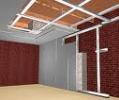
Public Hearing Set on CA Suspended Ceiling Change
The proposed changes to be discussed Aug. 19 are derived from the federal standards, 29 CFR 1926.451(a)(6) 1926.701(a), and will clarify who is responsible for determining how much weight a structure can bear.
California's Occupational Safety and Health Standards Board will conduct an Aug. 19 public hearing in Sacramento about a proposed change to Section 1709 of the state's Construction Safety Orders, which concerns maximum allowable loads that can be placed on a suspended ceiling and certain other structures. The change would make it clear construction employers may not subject a suspending ceiling to a load unless it is deemed safe by a qualified person with experience in structural design.
The change has been proposed because a Cal/OSHA citation against a plaster subcontractor was dismissed April 2, 2008, by an Occupational Safety and Health Appeals Board judge, who focused on the architect's design for the structure and concluded the subcontractor wasn't responsible for the building's design. The citation followed a serious injury of an employee. He was applying a coat of plaster to a suspended ceiling from a scaffold when the ceiling collapsed, and Cal/OSHA determined the ceiling's suspension system had failed.
Section 1709 sets requirements for load bearing capacity, bracing, wood floor construction, and erection guides for trusses and beams more than 25 feet long. The board's notice states that the proposed changes in the section are derived from the federal standards, 29 CFR 1926.451(a)(6) 1926.701(a). The existing Section 1709(a) says buildings or structures may not be overloaded in excess of their designed capacity; the term "design capacity" will be removed, and the changes will clarify who is responsible for determining how much weight a structure can bear.